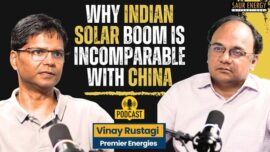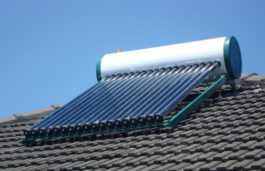Highlights :
- Caused mainly due to polysilicon price drops and a minor supply glut, the situation is expected to last well into the next two quarters.
- The news will be welcome for Indian developers in the process of reviving or completing delayed projects, as they take advantage of the lower prices.

Chinese solar module prices have reached their all-time lowest level, as the Chinese Module Marker (CMM) now stands at $0.173 per W. The CMM experienced an unprecedented decline of 11.73 per cent week-on-week over the past week, representing the largest percentage drop in its history.
Most of the downtrend has been attributed to firstly, the crash in polysilicon prices, which are down to almost CNY60/kg from peaks of over CNY320/kg seen in 2022, and secondly, the flood of modules in the market on the back of Chinese production increases. Markets like Europe are estimated to be sitting on 9 months to a year of inventory at the moment, driven by a Chinese push to lock up the market from other potential competitors, including from India.
Europe Fuels Supply Boom, Now Price Crash?
Last year, Europe underwent a significant transformation in its energy landscape, experiencing a remarkable surge in solar installations. A staggering 46.1 GW of solar capacity was added in 2022, marking an impressive 50 per cent increase compared to the previous year. With buyers willing to pay a better price for modules there as compared to India, sellers have made a beeline for the market, beefing up distribution and storage facilities along the way in anticipation of a sustained period of high demand.
Media reports indicate that approximately 85 GW of modules were shipped to Europe in 2022, of which 46 GW were installed, while the remaining modules ended up in warehouses owned by Chinese companies within Europe. As these warehouses have filled up, they have started affecting prices.
Increase in Manufacturing Capacity
Hopes that the latest supply glut (in Europe) and overall price drops would moderate will depend on the pace of fresh manufacturing capacities, that are coming up. As we highlighted at SaurEnergy, there is a global push for fresh manufacturing capacity across China, India, Europe and the US, in that order, and that portends peak manufacturing capacity in the next 3-4 years reaching close to a terawatt annually. As per BNEF data, there are enough factories right now to produce 657 gigawatts of solar modules a year, with another 336 gigawatts announced or under construction.
Numerous major corporations experienced a decline in their stock prices due to the compression of margins caused by falling prices, coupled with concerns of overcapacity resulting from factory expansions. Adding to the challenges faced by solar manufacturers, investors are now venturing into emerging sectors such as artificial intelligence. Consequently, the collective market capitalization of the four leading panel producers, all in China, has plummeted by more than 40 per cent since August.
China’s exports of solar panels have tripled over the past three years to reach nearly $5 billion per month. Longi, a major player in the industry, has expressed apprehension about the presence of excess capacity. They have warned that if the ongoing aggressive expansion of manufacturing capacity persists, more than half of China’s solar manufacturers could be forced out of the market within the next two to three years. The larger ones have sought to hedge their bets by backward integration in the supply chain, to ensure better control over their costs.
IMPLICATIONS
The drop in costs offers a solid window of opportunity for markets across the world, notably India (which has loosened conditions for imports), US, Europe and perhaps most importantly, countries across Africa, to ramp up installed solar capacity in the next 12-24 months. The capacity additions will serve to not just expand the market, but also improve availability of the right skill sets to ensure the growth can be sustained. Finding people with the right skillsets, be it on the installation side or the manufacturing side, are the only factors that seem capable of slowing down the current expansion across the solar supply chain, with capital in particular available in plenty for firms willing to make their bets.






























